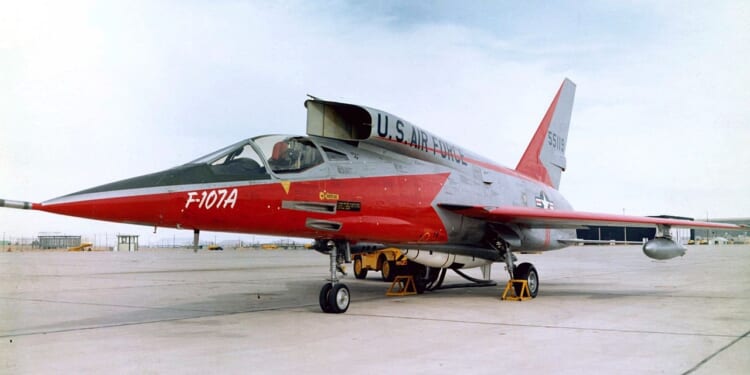In addition to its unusual air intake, the F-107 featured other unusual features: namely, an all-moving vertical stabilizer, an automated flight control system, and an ejection seat that was designed to blast through the aircraft’s non-jettisoning canopy.
Recently, The National Interest covered the F-100 Super Sabre, a one-time fastest jet in the world that had been the first of “The Century Series.” Most aviation enthusiasts know that the F-100 was developed from the famed F-86 Sabre, a first-generation fighter of the Korean War-era. But what many aviation enthusiasts probably don’t know is that the F-100 was developed further, into a prototype fighter-bomber known as the F-107.
While the F-107 was never given a formally designated name, the aircraft was informally known as the “Super Super Sabre,” or the “Ultra Sabre.” Only three F-107s were ever built before the program was cancelled—but the short-lived jet was notable for its incorporation of innovative, and indeed radical, design features that went on to influence later generations of aircraft.
How North American Aircraft Designed the F-107
North American Aircraft, which had successfully contracted with the U.S. Air Force for the F-86 and F-100 aircraft, set about, in 1953, developing the F-100 into a new tactical fighter-bomber with the hopes that the Air Force would be interested in purchasing the finished product. The design North American ultimately settled on would depart in many respects from the progenitor.
The most visually distinctive feature of the F-107, apparent to even casual observers, is its dorsal-mounted variable-area inlet duct (VAID). Whereas most air inlets are mounted beneath the fuselage, or straight through the center of the fuselage, or beneath the wings, the F-107’s inlet was mounted above the fuselage. Originally, the F-107’s inlet had been located in the chin position. But in an effort to conform to the Air Force’s requirement that their new jet feature an underbelly semi-conformal nuclear weapon, the intake was moved to the dorsal position. Situated just behind the cockpit, the dorsal inlet limited the pilot’s rear visibility, but as the F-107 was expected to engage with adversaries with missiles from beyond-visual-range (BVR), the hampered visibility was deemed an acceptable sacrifice. Aside from the distinct placement of the inlet, the F-107’s inlet also featured variable-area technology—at the time unique to the F-107. Today, the F-107’s variable-area technology is considered a predecessor to the variable-geometry intake ramp that is found on aircraft today.
The F-107 Was a Strange-Looking Bird
In addition to its unusual air intake, the F-107 featured other unusual features: namely, an all-moving vertical stabilizer, an automated flight control system, and an ejection seat that was designed to blast through the aircraft’s non-jettisoning canopy—a canopy that opened vertically on a guide mechanism, rather than on a more conventional hinge or horizontal slide.
The Air Force was impressed with the F-107. The so-called Super Super Sabre, which relied on one Pratt & Whitney YJ75-P-9 turbojet (good for 24,500 pounds of thrust), had a maximum speed of Mach 2, a service ceiling of 53,200 feet, and a rate of climb of nearly 40,000 feet per minute.
Ultimately, however, after careful consideration, the Air Force passed on the F-107, in favor of the Republic F-105 Thunderchief. The F-107 project was cancelled, and the Sabre line died with the three prototypes.
About the Author: Harrison Kass
Harrison Kass is a senior defense and national security writer with over 1,000 total pieces on issues involving global affairs. An attorney, pilot, guitarist, and minor pro hockey player, Harrison joined the US Air Force as a Pilot Trainee but was medically discharged. Harrison holds a BA from Lake Forest College, a JD from the University of Oregon, and an MA from New York University. Harrison listens to Dokken.
Image: Wikimedia Commons.















